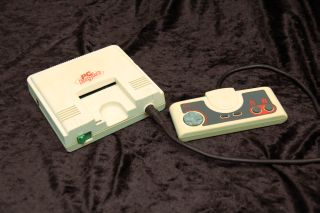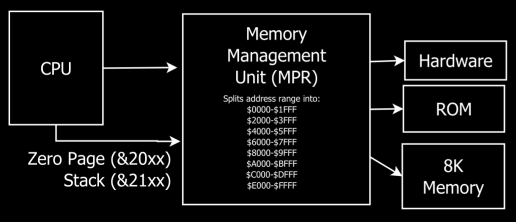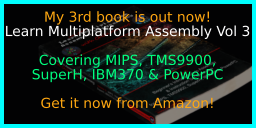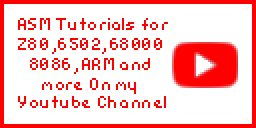

HuC6280 Assembly programming for the PC Engine! (TurboGrafx-16)
| The PC-Engine uses a super-charged
version of the 65c02... which itself is an improved version of the
6502 Known as the TurboGrafx-16, the PC-Engine is often mistaken for a 16 bit system because of its speed and graphical capability. There are various successors to the PC engine, but we'll only be covering the basic model. |
 |
||||||||||||||||||||||
|
ChibiAkumas Tutorials
Resources
PC Engine Docs - A
collection of PC Engine programming docs.
PC Engine GT Capacitor
list - For repairing the portable PC Engine
| The PC engine uses an effective 21
bit memory map... 13 bits of the address specified, and 8 bits
from the MPR register The topmost 3 bits are mapped through a Memory Management unit which maps to Ram/Rom or hardware This is all a bit confusing, but it's really pretty easy This Memory management unit has 8 registers, each of which handles a range of $2000 of the memory map, and a bank from $00-$FF... $FF is the hardware I/O ... $F8 is the 8k of basic ram... $00 is the first page of your cartridge rom. To page in a bank, we need to specify it by 'bit position' (so bank 7 has bit 7 set... so 128) we load A with the bitmask for that MPR, then use the special command TAM (transfer A to MPR) eg: - lets load bank $F8 into MPR page 1 ($2000-$3FFF) lda #$F8 ;ram bank TAM #2 ;bit 2 for bank 2 (%00000010) NOTE: The ZeroPage is at $2000 , and the Stack is at $2100 ... this is unaffected by the MPR's.... this causes problems in VASM, where if we try to write STA $0000 ... the assembler will optimize it to STA $00 |

|
Segments
| Bank | Purpose |
| $FF | I/O |
| $F9-$FB
|
SuperGrafx extra RAM (24k) |
| $F8 | PC Engine RAM (8k) |
| $F7 | Savegame RAM |
| $00-$F6 | HuCard ROM |
Vectors
| From (Logical) |
To (Logical) |
Purpose |
| $FFF6 |
$FFF7 |
IRQ2 (External) / BRK |
| $FFF8 |
$FFF9 |
IRQ1 (VDC / Vblank) |
| $FFFA |
$FFFB |
Timer interrupt |
| $FFFC |
$FFFD |
NMI |
| $FFFE |
$FFFF |
- |
| From (Physical) |
To (Physical) |
Purpose |
| $00 1FFE |
$00 1FFF |
Reset |
The Reset vector should be at $5FFE in your rom, and should contain "DW $E000" to start your program
IO Ports
| Address |
Purpose | Bits | Detail |
| $0000 | GPU Reg Select (ST0) | NNNNNNNN | reg N |
| $0002 | GPU Data L (ST1) | LLLLLLLL | Data L |
| $0003 | GPU Data H (ST2) | HHHHHHHH | Data H |
| $0400 | Palette: Reset | 00000000 | Write 0 to Reset |
| $0402 | Palette: Palette Entry L | PPPPPPPP | Palette num (0-511) |
| $0403 | Palette: Palette Entry H | -------P | Palette num (0-511) |
| $0404 | Palette: New Color L | GGRRRBBB | Color |
| $0405 | Palette: New Color H | -------G | Color |
| $0800 | Channel Select | -----CCC | Channel Select |
| $0801 | Main Amplitude Level | LLLLRRRR | L/R Volume |
| $0802 | Frequency L | LLLLLLLL | Frequency botttom 8 bits |
| $0803 | Frequency H | ----HHHH | Frequency top 4 bits |
| $0804 | Channel On/Write | ED-VVVVV | Enable (play)/write data... Direct digitaldata� channel Volume |
| $0805 | LR Volume | LLLLRRRR | L/R Volume |
| $0806 | Waveform Data | ---WWWWW | Wave data (write 32 times) |
| $0807 | Noise Enable | E--NNNNN | Enable noise� Noise freq (Chn 4/5 only) |
| $0808 | LFO Freq | FFFFFFF | Noise freq (Chn 4/5 only) |
| $0809 | LFO Control | T-----CC | lfo Trigger� Control |
| $1000 | Joypad (Write) | ------CS | C=CLR S=SEL |
| $1000 | Joypad (Read) | -C--DDDD | C=Country D=Joypad Data |
| $1402 | Interrupt Disable | -----T12 | T=Timer interrupt request, 1= IRQ1 (Vblank), 2=IRQ2 (1=disabled) |
| $1403 | Interrupt request | -----T12 | T=Timer interrupt request, 1= IRQ1 (Vblank),
2=IRQ2 (1=occurred) Write any values to clear Timer interrupt (Vblank is cleared by reading VDC Status at $0100) |
| $1Ax0-$1Ax1 | Data Port 0/1 |
DDDDDDDD |
4 versions... Reg x (0-3) |
| $1Ax2-$1Ax4 |
Base address (24 bit) |
$LLMMHH |
|
| $1Ax5-$1Ax6 |
Offset Register |
$LLHH |
|
| $1Ax7-$1Ax8 |
Increment Register |
$LLHH |
|
| $1Ax9 | Control Register |
SOOIoiNA |
A=AutoInc N=iNdex offset + base i=increment is signed o=offset is
signed I=apply increment to base(1) or offset(0)? OO=offset mode(None/Port0/Port1/Port0+1) S=Dataport size(0=Byte 1=Word) |
| $1AxA | Manual Register | Add offset to base | |
| $1AE0-$1AE3 |
$LLMMHHUU | Work Register (32 bit) | |
| $1AE4 |
Shift Register | ----SSSS | Signed Shift for work register |
| $1AE5 |
Rotate Register | ----RRRR | Signed Rotate for work register |
| $1AFE |
AC card version | DDDDDDDD | |
| $1AFF |
AC ID | DDDDDDDD | $51=Present |
| $1C00 | Timer Reload | -CCCCCCC | C=Counter |
| $1C01 | Timer Control | -------S | Timer Start/Stop |
The PC-Engine Graphics
system
| The PC Engine graphics hardware has 64k of ram... but it's
designed for 128k... it's controlled by a set of registers... we
have 3 hardware ports we use to control the hardware... these are
usually memory mapped to $0000 ... but we also have special commands
to quickly write fixed values to the graphics system We ALWAYS write data to the graphics system registers in HL byte pairs... Little Endian, so low byte first. To write data to the memory we set the address we want to write to with MAWR... but please note , we're only setting the last 16 of the 17 bits... for example, if we set MAWR to $3FFF (%11111111111111), the actual memory address will be %111111111111110 The effect is, that there are 2 bytes at VRAM $0000... and two bytes at VRAM $0001 ... and these bytes DO NOT OVERLAP!
Reading from Status register (eg LDA $0100) clears Vblank interrupt - otherwise it will 'refire'. |
Lets write &6543 to 'Byte Pair' at memory address &1234 (remember we always write in pairs):
st0 0 ;Select Register 0 - to select memory address to write to
st1 $34 ;Low byte of the memory address we want to write
st2 $12 ;High byte of the memory address we want to write
st0 2 ;Select Register 2 - to actually write data
st1 $43 ;Low byte of data to put in memory
st2 $65 ;High byte of data to put in memory
Graphics Registers
| Reg | Name | Meaning | Bits |
| 00 | MAWR | Memory Address Write | |
| 01 | MARR | Memory Address Read | |
| 02 | VRR/VWR | Vram Data Write / Vram Data Read | (AutoIncs
after Write) |
| 03 | Unused |
||
| 04 | Unused | ||
| 05 | CR | Control | - - - IW IW DR TE TE BB SB EX EX IE IE IE IE BB= Background on SB=Sprites on... IE bits 3-0 = Vblank / ScanLine match / SpriteOverflow / Collision |
| 06 | RCR | Scanning Line Detection | |
| 07 | BXR | BGX Scroll | |
| 08 | BYR | BGY Scroll | |
| 09 | MWR | Memory Access Width | - - - - - - - - CM SCR SCR SCR SM SM WV WV (SCR=Screen Width /Height %YXX) |
| 0A | HSR | Horizontal Sync | |
| 0B | HDR | Horizontal Display | |
| 0C | VPR | Vertical Sync | |
| 0D | BDW | Vertical Display | |
| 0E | BCR | Vertical Display End Position | |
| 0F | DCR | Block Transfer Control | |
| 10 | SOUR | Block Transfer Source Address | |
| 11 | DESR | Block Transfer Destination Address | |
| 12 | LENR | Block Transfer Length | |
| 13 | SATB | VRAM-SATB Block Transfer Source |
VRAM Layout
| Memory in the VRAM is not entirely fixed in purpose, this means
you can have weird effects, like using the same memory area for your
Tilemaps - and tile definitions (Patterns)... this is totally
useless, as one will corrupt the other, but we have to understand it's possible to understand the memory... as stated before, each address has 2 bytes... A Pattern (tile definition) is 32 bytes in size (4 bitplanes, 8 lines)... and because each memory address in the VRAM map contains 2 bytes... the pattern will take up 16 memory addresses... this means tile 0 starts at $0000... and tile 1 is at $0010 NOW... the TileMap has to be at $0000 .. and it takes AT LEAST $0400 (it's minimum size is 32x32, and each definition takes 2 bytes)... so we can't use tiles 0-64 for ease, it's probably easiest to start your pattern definitions at no 256 (memory address $1000) |
|
The PC engine uses two banks of 16 palettes of 16 colors each ... the first bank is for the tilemap (0-255), the second bank is for the sprites (256-511)
The Palette entries are controlled by special ports in the IO range in standard memory:
We write to $0402 and $0403 to select a palette entry, then define the new color for the palette entry by a 16 bit definition written to $0404 and $0405
| F | E | D | C | B | A | 9 | 8 | 7 | 6 | 5 | 4 | 3 | 2 | 1 | 0 | |
| - | - | - | - | - | - | - | G | G | G | R | R | R | B | B | B |
| Port | Purpose | 7
|
6
|
5
|
4
|
3
|
2
|
1
|
0
|
| $0400 | Write 0 to Reset | 0 | 0 | 0 | 0 | 0 | 0 | 0 | 0 |
| $0402 | Palette Entry L | P | P | P | P | P | P | P | P |
| $0403 | Palette Entry H | - | - | - | - | - | - | - | P |
| $0404 | New Color L | G | G | R | R | R | B | B | B |
| $0405 | New Color H | - | - | - | - | - | - | - | G |
| Palette Entry | Purpose | ||||||||
| 0-255 | Background | ||||||||
| 256-511 | Sprites |
Tilemap Definitions
| As with everything else on the PC engine Vram... each tile
definition takes one memory address, which contains 2 bytes... The top 4 bits pppp define a 16 color palette number from 0-15... The remaining 12 bits nnnn nnnnnnnn define the tile number - as stated, the first 64-256 probably can't be used because they overlap the tilemap... no's 2048-4095 CANNOT be used, as the memory these would use would be 64k-128k... and this memory is not installed in the PC Engine. |
ppppnnnn nnnnnnnn |
Tile definitions
Tile definitions use 4 bitplanes for 16 colors, and tile definitions are 8x8 - so 32 bytes ... Data is transferred in Words, and rather strangely we send bitplane 1+2 of lines, one at a time... then we do the same for bitplanes 3 and 4
| Byte 1 | Byte 2 | |
| First 16 bytes | 00111100 01111111 01100011 01100011 01111111 01100011 01100011 00000000 |
00222200 02222222 02200022 02200022 02222222 02200022 02200022 00000000 |
| Second 16 bytes | 00333300 03333333 03300033 03300033 03333333 03300033 03300033 00000000 |
00444400 04444444 04400044 04400044 04444444 04400044 04400044 00000000 |
Sprite Definitions
The PC Engine has 64 hardware sprites. The basic sprite size is 16x16, though larger sprites can be created by tilling them, for up to 32x64.... only neighboring sprites can be tilled. Sprites use the second set of palettes, from 256-511
Sprites are NOT in the same format as the tilemap, they are 16x16 with 4 bitplanes, but each plane is sent separately.
For Example lets look at a sprite, where all pixels are color 0 or color 15!
|
|
Sprites are stored in regular VRAM... the sprite definitions are stored in special ram which we CANNOT ACCESS...however we can allocate a bank of 256 addresses (each containing one word) called SATB, and then get the hardware to copy that ram to the special ram... it's suggested you use $7F00 for that purpose.
To start the copy we just write the address to control reg $13
SATB - Sprite attribute table buffer
The Sprite table allows for up to 64 sprites... each one has 4 words of data - making 256 words in total... the format is as follows
| Address | F | E | D | C | B | A | 9 | 8 | 7 | 6 | 5 | 4 | 3 | 2 | 1 | 0 | Notes | |
| 1 | - | - | - | - | - | - | Y | Y | Y | Y | Y | Y | Y | Y | Y | Y | Y=Ypos (64 is first visible line) | |
| 2 | - | - | - | - | - | - | X | X | X | X | X | X | X | X | X | X | X=Xpos (32 is first visible line) | |
| 3 | - | - | - | - | - | A | A | A | A | A | A | A | A | A | A | A | A=Address (Top 10 bits $trueaddress>>5 ) | |
| 4 | YF | - | YS | YS | XF | - | - | XS | F | - | - | - | P | P | P | P | YF=Yflip XF=Xflip YS=Ysize (16/32/64) XS=Xsize (16/32) F=Foreground (infront of tilemap) P=Palette (256+) |
Joypad port at $1000
Joypad reading is performed with Port $1000. This port uses 4 bits for reading, so two reads from this port are needed to get the 8 buttons of a joypad. The PC Engine is capable of supporting up to 5 joypads, though we'll only read in two in these tutorials
Before we can start reading, we need to initialize the 'Multitap' (the hardware that toggles the joypads). Ro do this we just write a #1 then #3 to port $1000... we need a short delay after each write....
Once the Multitap is initialized, we can get the direction and button states by alternating writes of #1 and #0 to port $1000 - this will return the buttons of all 5 joysticks in order.
| Joypad | Select bit (Bit 0 $1000) |
7 | 6 | 5 | 4 | 3 |
2 |
1 | 0 |
| 1 | 1 | CD addon (1=yes) |
Country (0=jpn) |
- | - | Left | Down | Right | Up |
| 1 | 0 | CD addon (1=yes) |
Country (0=jpn) |
- | - | Run | Start | B | A |
| 2 | 1 | CD addon (1=yes) |
Country (0=jpn) |
- | - | Left | Down | Right | Up |
| 2 | 0 | CD addon (1=yes) |
Country (0=jpn) |
- | - | Run | Start | B | A |
| The PC Engine
actually supports 5 joypads, but Joypads 3-5 work in exatly the
same way, we just need to keep reading in from the same port. |
 |
The PSG Sound generator
| The PC Engine PSG has 6 wave based
sound channels... each one uses 32 wave samples, of 5 bits each. We have to snd some commands to $0804 to tell the PSG we're going to write data.. then send the data to $0806 We also need to set the volumes correctly! To the right is a working example which will play a sound wave. |
lda #0 sta $0800;Channel Select lda #255 ;Mixing sta $0801 lda #1 ;Tone L sta $0802 lda #10 ;Tone H sta $0803 lda #%00011111 ;Chanel Op - Set 'Data Write' sta $0804 lda #%01011111 ;Chanel Op - Set 'Reset Write Address' sta $0804 lda #255 sta $0805 ;LR Volume ldy #4 ChibiSoundMoreWaves: lda #%00011111 sta $0806 sta $0806 sta $0806 sta $0806 lda #%00000000 sta $0806 sta $0806 sta $0806 sta $0806 dey bne ChibiSoundMoreWaves lda #%10011111 ;Chanel Op - Set 'Play' sta $0804 rts |
The PSG is controlled by 10 registers... first a channel should be selected with Register 0... Channels are numbered 0-5 (written 1-6 in the manuals)
| Reg | Address | Meaning | Channels | 7 | 6 | 5 | 4 | 3 | 2 | 1 | 0 | Bit Meaning |
| 0 | $0800 | Channel Select | All | - | - | - | - | - | C | C | C | Channel Select |
| 1 | $0801 | Main Amplitude Level | All | L | L | L | L | R | R | R | R | L/R Volume |
| 2 | $0802 | Frequency L | 0-5 | L | L | L | L | L | L | L | L | Frequency botttom 8 bits |
| 3 | $0803 | Frequency H | 0-5 | - | - | - | - | H | H | H | H | Frequency top 4 bits |
| 4 | $0804 | Channel On/Write | 0-5 | E | D | - | V | V | V | V | V | Enable (play)/write data... Direct digitaldata� channel Volume |
| 5 | $0805 | LR Volume | 0-5 | L | L | L | L | R | R | R | R | L/R Volume |
| 6 | $0806 | Waveform Data | 0-5 | - | - | - | W | W | W | W | W | Wave data (write 32 times) |
| 7 | $0807 | Noise Enable | 0-5 | E | - | - | N | N | N | N | N | Enable noise� Noise freq (Chn 4/5 only) |
| 8 | $0808 | LFO Freq | All | F | F | F | F | F | F | F | F | lfo Frequency |
| 9 | $0809 | LFO Control | All | T | - | - | - | - | - | C | C | lfo Trigger� Control |
| View Options |
| Default Dark |
| Simple (Hide this menu) |
| Print Mode (white background) |
| Top Menu |
| ***Main Menu*** |
| Youtube channel |
| Patreon |
| Introduction to Assembly (Basics for absolute beginners) |
| Amazon Affiliate Link |
| AkuSprite Editor |
| ChibiTracker |
| Dec/Bin/Hex/Oct/Ascii Table |
| Alt Tech |
| Archive.org |
| Bitchute |
| Odysee |
| Rumble |
| DailyMotion |
| Please note: I wlll upload more content to these alt platforms based on the views they bring in |
| 68000 Content |
| ***68000 Tutorial List*** |
| Learn 68000 Assembly |
| Hello World Series |
| Platform Specific Series |
| Simple Samples |
| Grime 68000 |
| 68000 Downloads |
| 68000 Cheatsheet |
| Sources.7z |
| DevTools kit |
| 68000 Platforms |
| Amiga 500 |
| Atari ST |
| Neo Geo |
| Sega Genesis / Mega Drive |
| Sinclair QL |
| X68000 (Sharp x68k) |
| 8086 Content |
| Learn 8086 Assembly |
| Platform Specific Series |
| Hello World Series |
| Simple Samples |
| 8086 Downloads |
| 8086 Cheatsheet |
| Sources.7z |
| DevTools kit |
| 8086 Platforms |
| Wonderswan |
| MsDos |
| ARM Content |
| Learn ARM Assembly |
| Learn ARM Thumb Assembly |
| Platform Specific Series |
| Hello World |
| Simple Samples |
| ARM Downloads |
| ARM Cheatsheet |
| Sources.7z |
| DevTools kit |
| ARM Platforms |
| Gameboy Advance |
| Nintendo DS |
| Risc Os |
| Risc-V Content |
| Learn Risc-V Assembly |
| Risc-V Downloads |
| Risc-V Cheatsheet |
| Sources.7z |
| DevTools kit |
| MIPS Content |
| Learn Risc-V Assembly |
| Platform Specific Series |
| Hello World |
| Simple Samples |
| MIPS Downloads |
| MIPS Cheatsheet |
| Sources.7z |
| DevTools kit |
| MIPS Platforms |
| Playstation |
| N64 |
| PDP-11 Content |
| Learn PDP-11 Assembly |
| Platform Specific Series |
| Simple Samples |
| PDP-11 Downloads |
| PDP-11 Cheatsheet |
| Sources.7z |
| DevTools kit |
| PDP-11 Platforms |
| PDP-11 |
| UKNC |
| TMS9900 Content |
| Learn TMS9900 Assembly |
| Platform Specific Series |
| Hello World |
| TMS9900 Downloads |
| TMS9900 Cheatsheet |
| Sources.7z |
| DevTools kit |
| TMS9900 Platforms |
| Ti 99 |
| 6809 Content |
| Learn 6809 Assembly |
| Learn 6309 Assembly |
| Platform Specific Series |
| Hello World Series |
| Simple Samples |
| 6809 Downloads |
| 6809/6309 Cheatsheet |
| Sources.7z |
| DevTools kit |
| 6809 Platforms |
| Dragon 32/Tandy Coco |
| Fujitsu FM7 |
| TRS-80 Coco 3 |
| Vectrex |
| 65816 Content |
| Learn 65816 Assembly |
| Hello World |
| Simple Samples |
| 65816 Downloads |
| 65816 Cheatsheet |
| Sources.7z |
| DevTools kit |
| 65816 Platforms |
| SNES |
| eZ80 Content |
| Learn eZ80 Assembly |
| Platform Specific Series |
| eZ80 Downloads |
| eZ80 Cheatsheet |
| Sources.7z |
| DevTools kit |
| eZ80 Platforms |
| Ti84 PCE |
| IBM370 Content |
| Learn IBM370 Assembly |
| Simple Samples |
| IBM370 Downloads |
| IBM370 Cheatsheet |
| Sources.7z |
| DevTools kit |
| Super-H Content |
| Learn SH2 Assembly |
| Hello World Series |
| Simple Samples |
| SH2 Downloads |
| SH2 Cheatsheet |
| Sources.7z |
| DevTools kit |
| SH2 Platforms |
| 32x |
| Saturn |
| PowerPC Content |
| Learn PowerPC Assembly |
| Hello World Series |
| Simple Samples |
| PowerPC Downloads |
| PowerPC Cheatsheet |
| Sources.7z |
| DevTools kit |
| PowerPC Platforms |
| Gamecube |
| Work in Progress |
| ChibiAndroids |
| Misc bits |
| Ruby programming |
Buy my Assembly programming book
on Amazon in Print or Kindle!



Available worldwide!
Search 'ChibiAkumas' on
your local Amazon website!
Click here for more info!


Buy my Assembly programming book
on Amazon in Print or Kindle!



Available worldwide!
Search 'ChibiAkumas' on
your local Amazon website!
Click here for more info!


Buy my Assembly programming book
on Amazon in Print or Kindle!



Available worldwide!
Search 'ChibiAkumas' on
your local Amazon website!
Click here for more info!

